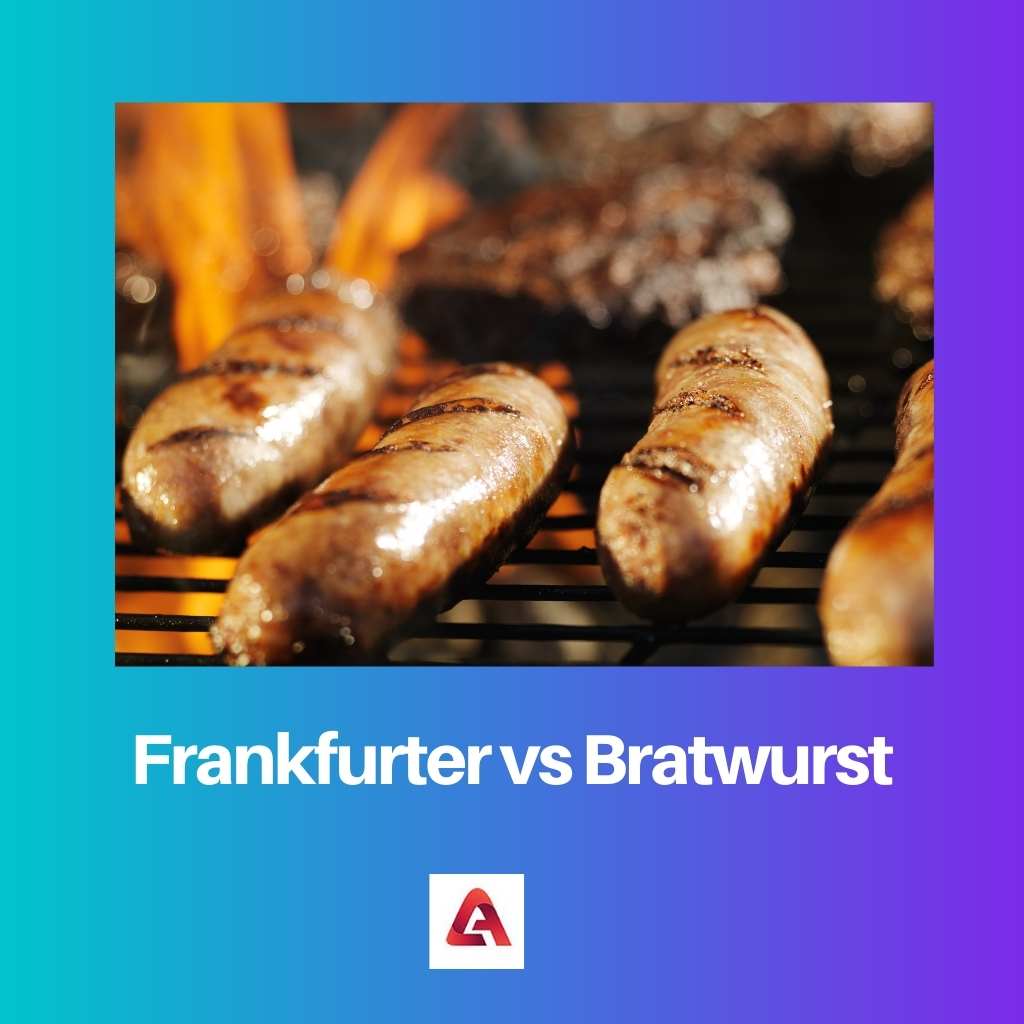Sausages have long been considered a staple dish around the globe, either as a standalone meal or as part of a larger dish. However, sausage is a common term for a meat alternative that is far more complicated than meets the eye.
Because there are numerous options available on the market, each has its own set of complexities. The two being contrasted here, however, are the frankfurter and the bratwurst.
Key Takeaways
- Frankfurters are smoked, thin sausages made from beef and pork, while bratwursts are thicker, fresh sausages made from ground pork, beef, or veal and seasoned with various spices.
- Frankfurters are commonly associated with American-style hot dogs, while bratwursts are a traditional German sausage with regional variations in flavor and preparation.
- Both frankfurters and bratwursts are popular types of sausages enjoyed grilled, boiled, or pan-fried and are served with bread, mustard, or sauerkraut.
Frankfurter vs Bratwurst
A Frankfurter is a type of sausage that is made from pork, although beef may also be used. It originated in the city of Frankfurt, Germany, and is also known as a “Frankfurter Würstchen”. A Bratwurst is a type of sausage that is also popular in Germany, particularly in the state of Bavaria. It is made from pork, although beef or veal may also be used.

A Frankfurter is a slim partially cooked sausage prepared from pure pork in a sheep’s intestine casing. The flavor is obtained through a low-temperature smoking technique.
Frankfurters are not always cooked before consumption; they are only warmed in hot water for around eight minutes to protect the skin from exploding.
Bratwurst is a kind of sausage that is closely linked with Germany, where it emerged. The sausage is strongly spiced and delivered with mustard and a hard roll, though it is provided diversely in some places.
Many supermarkets and butcher shops sell bratwurst, and you can also purchase German sausage from a specialized vendor.
Comparison Table
| Parameter of comparison | Frankfurter | Bratwurst |
|---|---|---|
| Outlook | Regular and thin. | Thick and long. |
| Calories | Fewer calories. | A little more calories than in frankfurter. |
| Texture | Slippery or smooth surface. | Juicy but coarse in texture. |
| Where to find | More commonly found and is spread all across the continent. | It is limited to sports stadiums. |
| Cooking | Can be cooked in Bain Maries. | Not a method recommended for the Bratwurst. |
What is Frankfurter?
Frankfurters, also known as a wiener or hot dog in the U. S., is an extremely seasoned sausage made of a mixture of beef and pork.
Frankfurters are given the name after Frankfurt am Main, Germany, where they were first marketed and consumed in beer gardens.
Frankfurters were presented to the United States around 1900 and fastly became synonymous with American cuisine.
In 1916, the first so-called hot-dog display launched in Coney Island, New York, marketing the sausages as a sandwich on what is now the basic long hot-dog bun.
The hot dog stayed mainstream all through the twentieth and early twenty-first centuries, particularly at barbecues, picnics, and sporting events.
Frankfurters are sold bare, vacuum-packed, or bottled, ready-cooked and softly smoked, to be cooked by grilling, steaming, or mild, quick boiling.
The German and Austrian frankfurter is also recognized as a würstchen, or “little sausage,” and there are multiple kinds of these sausages.
Frankfurters are consumed hot with sauerkraut in Germany and Austria, and chilly with potato salad if gently smoked.
The average American frankfurter is 55 % water, 28–30 % fat and 12–15 % protein. There are also all-beef and turkey frankfurters available, as well as low-fat variants.
Most competitively marketed frankfurters comprise sodium or potassium nitrates, which inhibit the development of the botulism-causing type of bacteria Clostridium botulinum and protect the meat’s distinctive red hue, which would normally be lost during processing.

What is Bratwurst?
Bratwursts, or brats, are a kind of German sausage. In Germany, the phrase “bratwurst” refers to all sausages: “brat” refers to ground meat, and “wurst” refers to sausage.
Bratwursts are made with pork and veal, but they’re also created with beef and veal or any other pairing of meat.
The seasonings, specifically marjoram, distinguish German bratwursts. Ginger, paprika, sage, cumin, nutmeg, coriander, and caraway are some other prevalent bratwurst spices.
Bratwurst is purchased as a raw, fresh sausage in its organic casing or as a link sausage. Brats can be grilled, boiled, or simmered in beer, which is a prevalent preparedness in Wisconsin.
Brats can be served in a stew, on a sandwich, or as a main course with sauerkraut and potato salad. Mustard, ketchup, relish, slaw, and aioli are common brat toppings.
Although bratwursts are a sort of sausage, not all sausages are bratwursts.
Sausages with an organic or inorganic casing can be found in the supermarket or butcher shop, whereas bratwursts have an organic shell made from animal intestines or skin.
Some sausages are managed to sell pre-cooked or smoked, which eliminates the need for cooking. Bratwursts are sold fresh, with raw meat, and must be cooked.

Main Differences Between Frankfurter and Bratwurst
- Frankfurter has a thin and regular outlook while bratwurst is thick and long.
- Frankfurter has fewer calories while bratwurst has comparatively more calories.
- Frankfurter has a slippery or smooth surface while bratwurst is juicy but coarse in texture.
- Frankfurters are more commonly found and are spread all across the continent while bratwurst is limited to sports stadiums.
- Frankfurter can be cooked in Bain Maries while it is not a method recommended for bratwurst.

- https://onlinelibrary.wiley.com/doi/abs/10.1111/j.1745-4565.2010.00232.x
- https://www.agriculturejournals.cz/publicFiles/65_2009-CJFS.pdf
